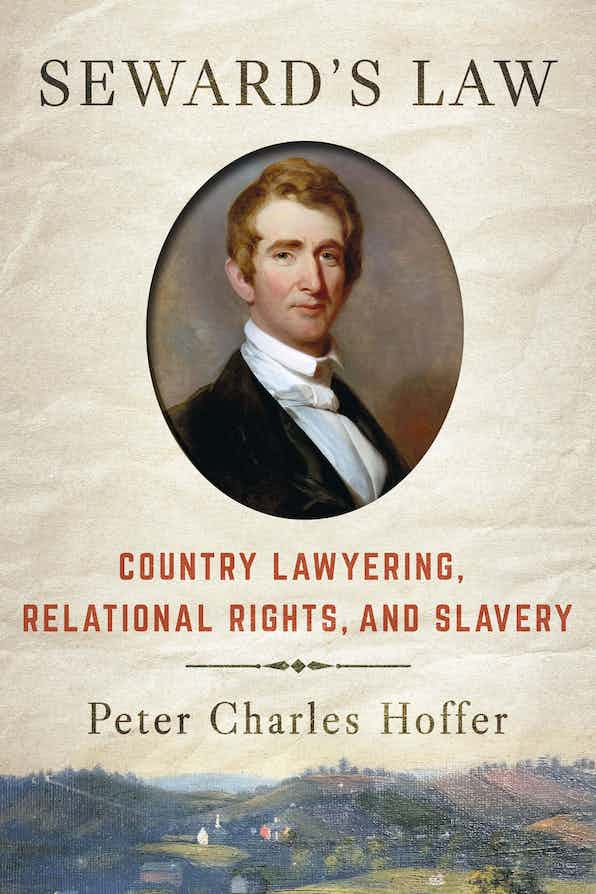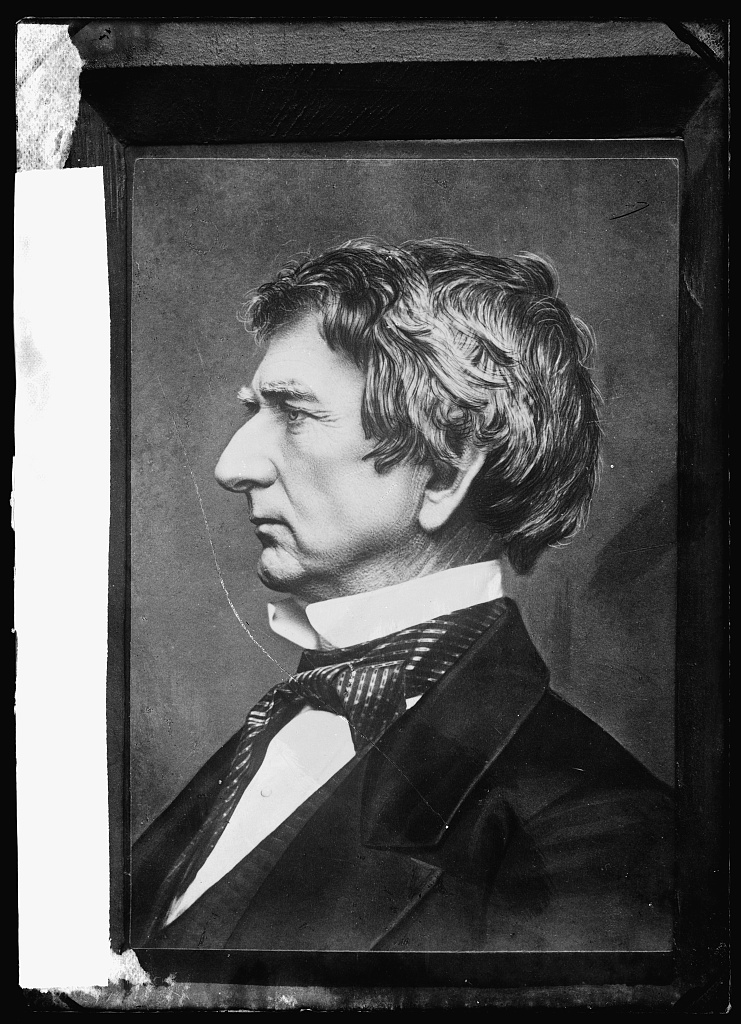Peter Hoffer’s Seward’s Law: Country Lawyering, Relational Rights, and Slavery (Cornell University Press: Ithaca, NY, 2023) spotlights William Seward (most famous for his purchase of Alaska on behalf of the United States) to argue that Seward’s experiences as a “country lawyer” gave rise to a theory of “relational rights” that sidestepped the traditional antipodes of the slavery debate. The first half of that thesis, that Seward’s “jurisprudential instincts” developed in the course of his early career as a generalist lawyer in upstate New York is little more than a truism; who will deny that one’s experiences will shape his principles and mores?[1] The second half of that thesis may be more interesting, that Seward’s approach to slavery eschewed the usual poles—virulent racism seeking to protect ownership of enslaved Black people on the one hand and full-throated defenses of Black personhood and integrality to the democratic project on the other. This is a thesis less likely to interest lawyers or even legal historians than it is more generalist American historians of the 19th century, an audience Hoffer speaks to effectively. But what is this theory of “relational rights” Hoffer draws out of Seward’s archive? Where did it come from?

Hoffer’s introduction expounds on the idea of the “country lawyer.” The country lawyer did not deal in high-minded ideals and absolute conceptions of rights; to the extent that he held views on such matters, they did not often find expression in court. Rather, the country lawyer dealt with legal rights in the private law sense of the phrase—for example, possessory rights in land, and rights to collect debts. In Hoffer’s view of relational rights, these were the rights that required negotiation and mediation between parties—work that enlisted country lawyers like Seward. Seward, Hoffer argues, took those lessons with him as he ascended the ranks of the political establishment—from state senator to governor, and eventually Secretary of State—and these lessons might provide some explanation to Seward’s decision-making.
Chapter 1 provides a brief biographical sketch and gives readers a first glimpse at Seward’s personal characteristics, and how he was received by both his contemporaries and the historians who have adjudged him. Seward, in Hoffer’s account, was an abolitionist from a young age and born to a well-off professional family. Seward’s contemporaries would describe him as “cunning” but “blustering,” leading historians to declare him arrogant, calculating, and loquacious, and few historians would describe Seward as “an original thinker,” (prior to Hoffer’s account, he implies).[2] As Seward established his law practice through appearances in state and federal courts, he also dabbled in politics, winning a seat as a state senator and eventually ascending to the governorship of New York. Seward’s governorship was marked by the “Virginia affair,” when Seward refused to extradite to Virginia three free Black sailors who had given refuge to an enslaved Virginia carpenter on the grounds that the three men had committed no unlawful act under New York law, and thus Seward was under no obligation to give up three citizens of New York to Virginia (particularly in light of Seward’s discretion as governor). In Hoffer’s view, this incident reflects the translation of relational rights from the domain of private law (where individuals negotiate rights) to the domain of public law (where states must negotiate rights among themselves), which continued to play out as Virginia and New York continued to pass laws antagonizing each other, though Seward refused to back down from upholding New York’s commitment to free soil.

The second chapter opens with Seward’s departure from the governorship in 1842, a period during which Seward’s work as a litigator provided him with opportunities to try and make the case for a theory of relational rights to juries and judges throughout the state to little success. Seward also litigated on behalf of Black defendants, leading Hoffer to remark that though Seward’s defense “conceded the local assumption that the Black man was morally and intellectually inferior to his white neighbors…[and] Seward shared something of these assumptions…that did not mean any diminution in his dislike of slavery.”[3] Seward also defended a white farmer charged with harboring a fugitive slave. Seward’s argument hinged not on the moral turpitude of slavery but instead on the view that “hospitality to strangers” was a moral principle that supported his client and was more foundational to American life than the Constitution, though it won no sympathizers on the bench.
Chapters Three and Four focus on Seward’s views towards slavery, first by focusing on a speech he made in the United States Senate decrying slavery and capitalism’s reliance on it (what would come to be known as Seward’s “higher law” speech), and then by honing in on the speeches Seward made while stumping for Republican candidates in the 1856 election. In one such speech, Seward decried slavery as an institution born of the Iberian Peninsula as opposed to “The free-labor system…of German extraction, …established in our country by emigrants from Sweden, Holland, Germany, Great Britain, and Ireland.”[4] Though Hoffer describes this move as both ethnocentric and as a lawyerly artifice, Hoffer offers no significant criticism of Seward’s shrewd exploitation of the fault lines among European immigrants. Instead, Hoffer focuses on the consequences of Seward’s views—that Seward’s abolitionism (gradualist as it was) ultimately may have cost Seward a chance at the Republican nomination for President in 1860.
As Hoffer acknowledges in the fifth chapter, it was Seward’s cabinet position as Secretary of State beginning in 1861 that would confront him with the most serious challenge to relational rights jurisprudence—in Hoffer’s elegant formulation, “How could one use a jurisprudence of reciprocity when some in the community explicitly rejected the very idea of reciprocity”?[5] Seward appears conciliatory and bellicose by turns as needed to try and prevent secession, but as secession began and Lincoln suspended habeas corpus, Seward used his broad powers to arrest and detain individuals even where evidence of sedition was tenuous. Hoffer remarks on this apologetically that Seward was a legalist who released those detainees in short order, though in the same breath Hoffer describes how Seward punished his political enemy Franklin Pierce for little more than political motives, as well as Democratic senator George Jones. Seward’s main and official role, however, was to manage the diplomatic relations of the United States, chiefly by preventing France, England, and other European nations from forging an alliance with the Confederacy—a task that strained during the US encroachment on a British ship in the Trent affair, but ultimately was resolved without much further incident.
In the final chapters, Hoffer recounts Seward’s internal difficulties with the conclusion of the Civil War—not the moderate, gradual emancipation of enslaved persons he had sought, but instead the immediate liberation of Confederate slaves and the end of slavery throughout the reconstituted United States through the Thirteenth and Fourteenth Amendments. Hoffer paints Seward as a man of moderate and diplomatic temperament whose political sensibilities prevented him from embracing anything less than a gradualist abolitionism while his moral compass demanded full and immediate abolition. Here, Hoffer misses an opportunity to interrogate the failures of relational rights—namely that its core principles of respecting private rights, particularly those in property, cannot co-exist with immediate abolition sans compensation to enslavers. Seward, in the aftermath of the War, remained a loyal cabinet member to both Lincoln and Johnson, culminating in his purchase of Alaska (widely mocked at the time). As Hoffer notes in his conclusion, the relative obscurity to which history has relegated Seward may fail to give sufficient pride of place to the jurisprudence of relational rights, even as it re-emerged in the development of the twentieth-century welfare state.
Though much of Hoffer’s text reads as panegyric, it becomes much more measured and even-handed about Seward’s jurisprudence in the end. Beyond this, there is little with which to quibble. However, a problem throughout the book is that Hoffer does not explain why Seward’s relational rights jurisprudence failed. This shortcoming might be the inevitable result of Hoffer’s chosen genre of biography. The work of biography requires a narrow focus—a focus that makes developing theories of historical causation or intellectual currents difficult. A man’s life in isolation cannot uphold broader generalities without significant dilation (and dilution) of focus. Hoffer seeks to make relational rights jurisprudence useful by explaining where it bubbles up in Seward’s thought. Yet in so doing, Hoffer does not explain why relational rights jurisprudence failed. A possible explanation might be that since relational rights jurisprudence was fundamentally about entitlements and rights modeled on property, it cannot support the abolition of slavery. Disappointing, too, is Hoffer’s reluctance to recognize Seward’s relational rights jurisprudence as what it is: an end run around the pressing moral, legal, and political contradictions that threatened slavery from its inception. Still, Hoffer deserves recognition for toiling in the archives to uncover a key intellectual thread from Seward’s legal thought.
[1] Peter Charles Hoffer, Seward’s Law: Country Lawyering, Relational Rights, and Slavery (Ithaca: Cornell University Press, 2023), 2.
[2] Ibid., 9.
[3] Ibid., 37.
[4] Ibid., 83.
[5] Ibid., 96.

